2019 TOYOTA PRIUS PLUS seats
[x] Cancel search: seatsPage 2 of 568

TABLE OF CONTENTS2
PRIUS +_OM_OM47D30E_(EE)
For your information .......................8
Reading this manual.....................12
How to search ..............................13
Pictorial index ...............................14
1-1. For safe use
Before driving.......................34
For safe driving ....................36
Seat belts .............................38
SRS airbags.........................46
Airbag manual on-off
system ...............................56
Safety information for
children ..............................58
Child restraint systems ........59
Installing child restraints ......67
Exhaust gas precautions .....80
1-2. Hybrid system
Hybrid system features ........81
Hybrid system
precautions ........................85
1-3. Theft deterrent system
Immobilizer system ..............91
Double locking system .......103
Alarm .................................104
2. Instrument cluster
Warning lights and
indicators......................... 112
Gauges and meters........... 117
Multi-information
display ............................. 126
Energy monitor/
consumption screen ........ 134
3-1. Key information
Keys .................................. 140
3-2. Opening, closing and
locking the doors
Side doors ......................... 144
Back door .......................... 148
Smart entry & start
system............................. 153
3-3. Adjusting the seats
Front seats ........................ 187
Second seats .................... 191
Third seats ........................ 196
Head restraints .................. 199
1For safety and security
2Instrument cluster
3Operation of each
component
Page 22 of 568
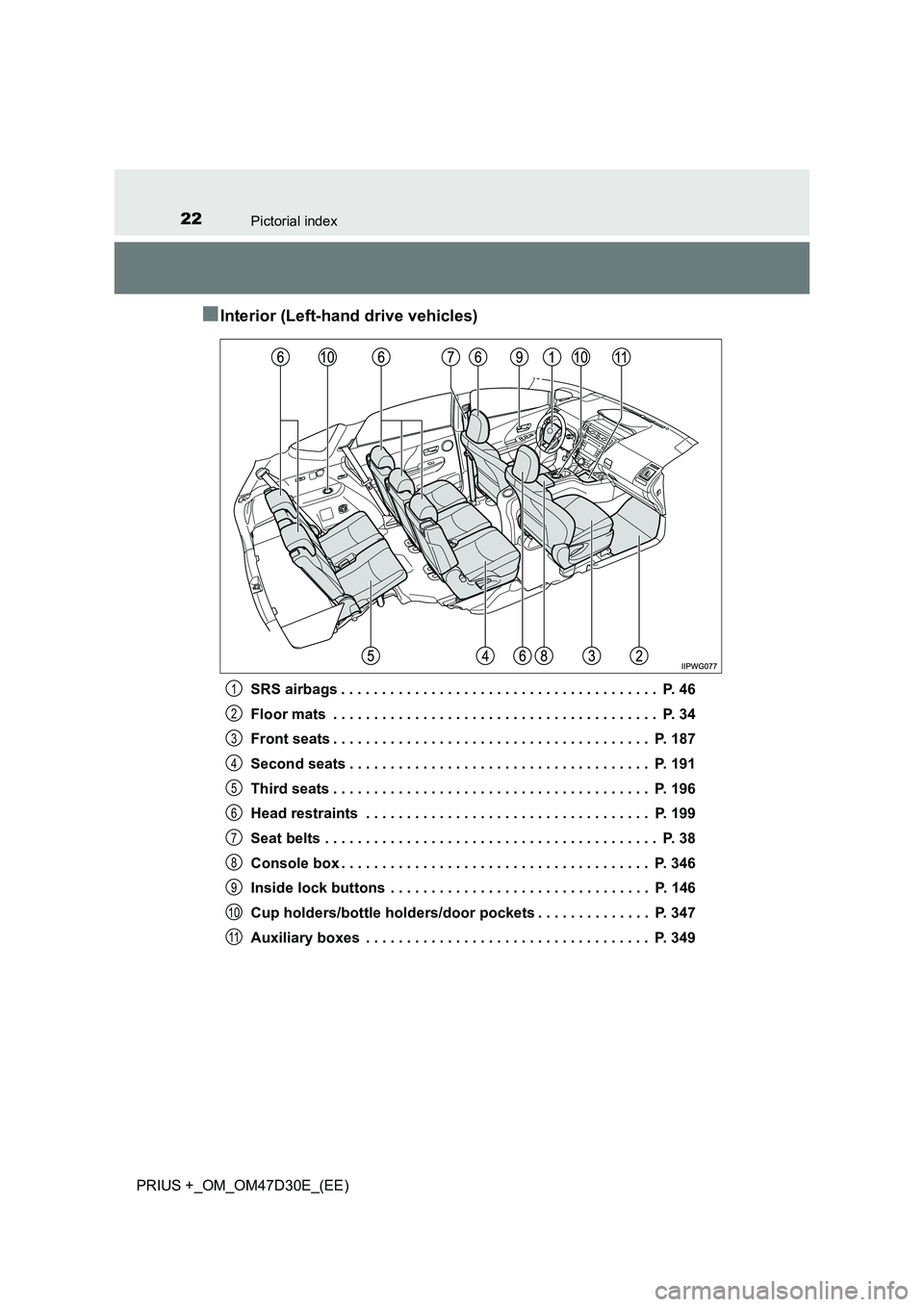
22Pictorial index
PRIUS +_OM_OM47D30E_(EE)
■Interior (Left-hand drive vehicles)
SRS airbags . . . . . . . . . . . . . . . . . . . . . . . . . . . . . . . . . . . . . . . P. 46
Floor mats . . . . . . . . . . . . . . . . . . . . . . . . . . . . . . . . . . . . . . . . P. 34
Front seats . . . . . . . . . . . . . . . . . . . . . . . . . . . . . . . . . . . . . . . P. 187
Second seats . . . . . . . . . . . . . . . . . . . . . . . . . . . . . . . . . . . . . P. 191
Third seats . . . . . . . . . . . . . . . . . . . . . . . . . . . . . . . . . . . . . . . P. 196
Head restraints . . . . . . . . . . . . . . . . . . . . . . . . . . . . . . . . . . . P. 199
Seat belts . . . . . . . . . . . . . . . . . . . . . . . . . . . . . . . . . . . . . . . . . P. 38
Console box . . . . . . . . . . . . . . . . . . . . . . . . . . . . . . . . . . . . . . P. 346
Inside lock buttons . . . . . . . . . . . . . . . . . . . . . . . . . . . . . . . . P. 146
Cup holders/bottle holders/door pockets . . . . . . . . . . . . . . P. 347
Auxiliary boxes . . . . . . . . . . . . . . . . . . . . . . . . . . . . . . . . . . . P. 3491
2
3
4
5
6
7
8
9
10
11
Page 30 of 568
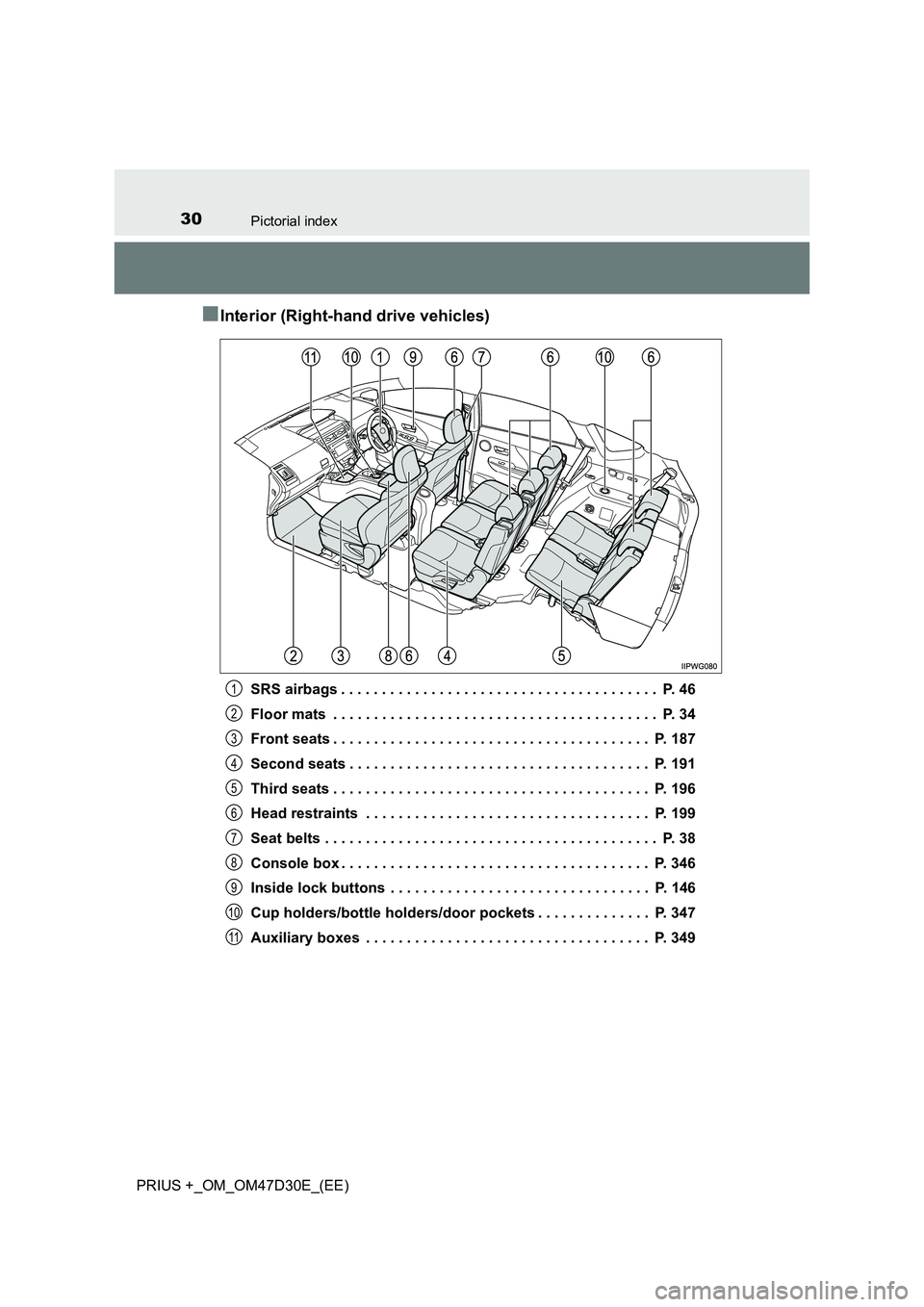
30Pictorial index
PRIUS +_OM_OM47D30E_(EE)
■Interior (Right-hand drive vehicles)
SRS airbags . . . . . . . . . . . . . . . . . . . . . . . . . . . . . . . . . . . . . . . P. 46
Floor mats . . . . . . . . . . . . . . . . . . . . . . . . . . . . . . . . . . . . . . . . P. 34
Front seats . . . . . . . . . . . . . . . . . . . . . . . . . . . . . . . . . . . . . . . P. 187
Second seats . . . . . . . . . . . . . . . . . . . . . . . . . . . . . . . . . . . . . P. 191
Third seats . . . . . . . . . . . . . . . . . . . . . . . . . . . . . . . . . . . . . . . P. 196
Head restraints . . . . . . . . . . . . . . . . . . . . . . . . . . . . . . . . . . . P. 199
Seat belts . . . . . . . . . . . . . . . . . . . . . . . . . . . . . . . . . . . . . . . . . P. 38
Console box . . . . . . . . . . . . . . . . . . . . . . . . . . . . . . . . . . . . . . P. 346
Inside lock buttons . . . . . . . . . . . . . . . . . . . . . . . . . . . . . . . . P. 146
Cup holders/bottle holders/door pockets . . . . . . . . . . . . . . P. 347
Auxiliary boxes . . . . . . . . . . . . . . . . . . . . . . . . . . . . . . . . . . . P. 3491
2
3
4
5
6
7
8
9
10
11
Page 37 of 568

371-1. For safe use
1
PRIUS +_OM_OM47D30E_(EE)
For safety and security
WARNING
Observe the following precautions.
Failure to do so may result in death or serious injury.
● Do not adjust the position of the driver’s seat while driving.
Doing so could cause the driver to lose control of the vehicle.
● Do not place a cushion between the driver or passenger and the seatback.
A cushion may prevent correct posture from being achieved, and reduce
the effectiveness of the seat belt and head restraint.
● Do not place anything under the front seats.
Objects placed under the front seats may become jammed in the seat
tracks and stop the seat from locking in place. This may lead to an acci-
dent and the adjustment mechanism may also be damaged.
● Always observe the legal speed limit when driving on public roads.
● When driving over long distances, take regular breaks before you start to
feel tired.
Also, if you feel tired or sleepy while driving, do not force yourself to con-
tinue driving and take a break immediately.
Page 41 of 568
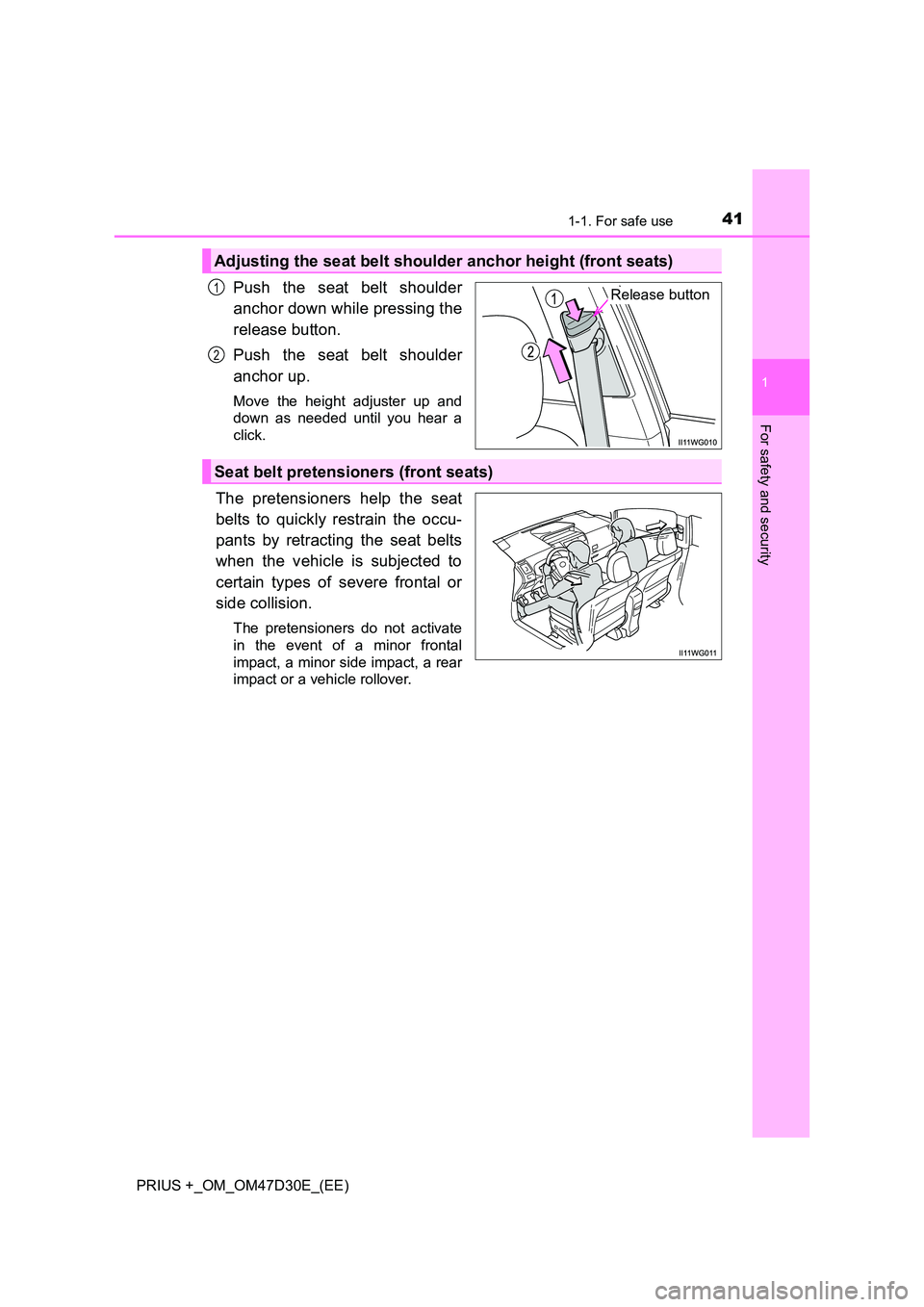
411-1. For safe use
1
PRIUS +_OM_OM47D30E_(EE)
For safety and security
Push the seat belt shoulder
anchor down while pressing the
release button.
Push the seat belt shoulder
anchor up.
Move the height adjuster up and
down as needed until you hear a
click.
The pretensioners help the seat
belts to quickly restrain the occu-
pants by retracting the seat belts
when the vehicle is subjected to
certain types of severe frontal or
side collision.
The pretensioners do not activate
in the event of a minor frontal
impact, a minor side impact, a rear
impact or a vehicle rollover.
Adjusting the seat belt shoulder anchor height (front seats)
Release button1
2
Seat belt pretensioners (front seats)
Page 43 of 568
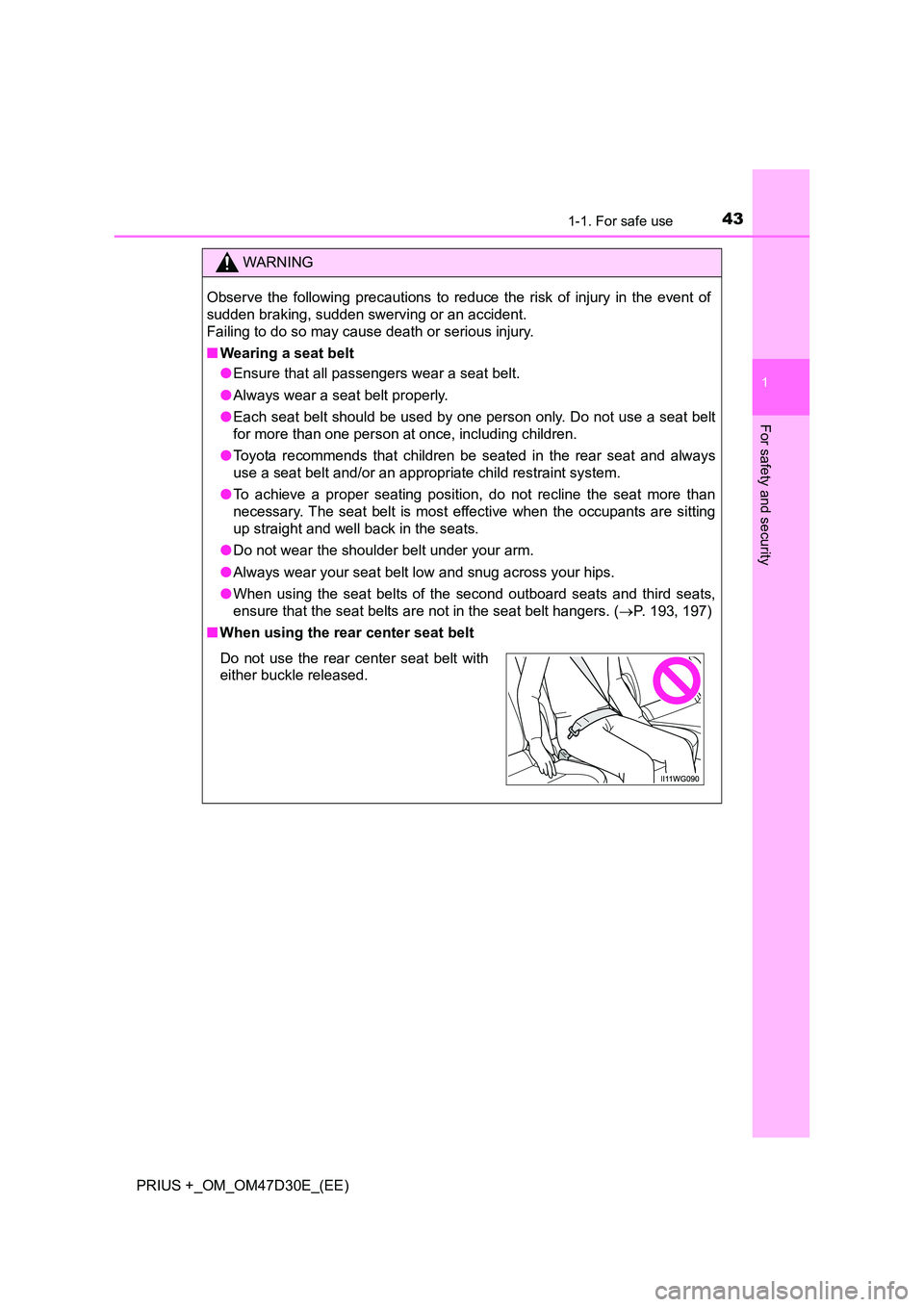
431-1. For safe use
1
PRIUS +_OM_OM47D30E_(EE)
For safety and security
WARNING
Observe the following precautions to reduce the risk of injury in the event of
sudden braking, sudden swerving or an accident.
Failing to do so may cause death or serious injury.
■ Wearing a seat belt
● Ensure that all passengers wear a seat belt.
● Always wear a seat belt properly.
● Each seat belt should be used by one person only. Do not use a seat belt
for more than one person at once, including children.
● Toyota recommends that children be seated in the rear seat and always
use a seat belt and/or an appropriate child restraint system.
● To achieve a proper seating position, do not recline the seat more than
necessary. The seat belt is most effective when the occupants are sitting
up straight and well back in the seats.
● Do not wear the shoulder belt under your arm.
● Always wear your seat belt low and snug across your hips.
● When using the seat belts of the second outboard seats and third seats,
ensure that the seat belts are not in the seat belt hangers. ( P. 193, 197)
■ When using the rear center seat belt
Do not use the rear center seat belt with
either buckle released.
Page 46 of 568
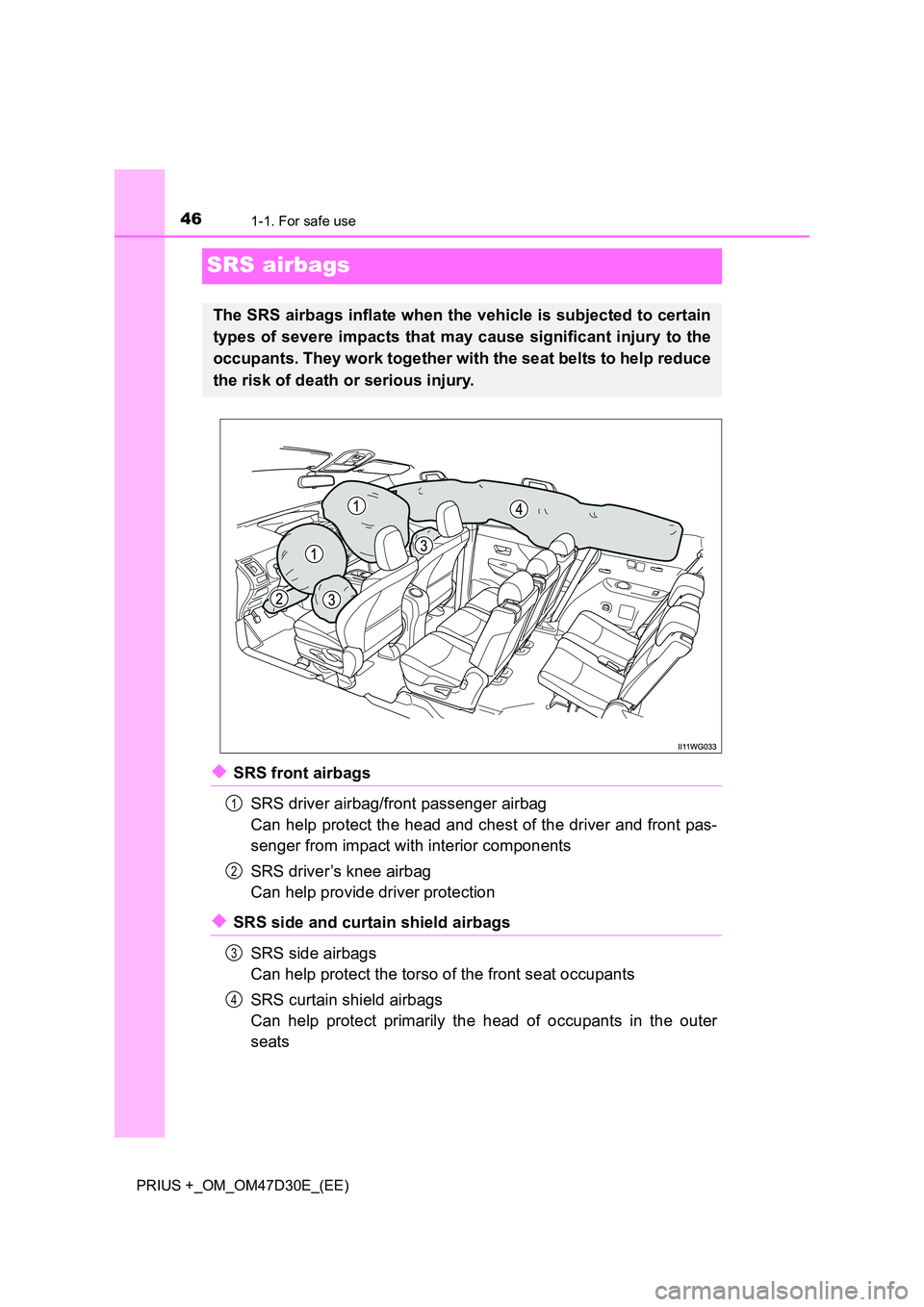
461-1. For safe use
PRIUS +_OM_OM47D30E_(EE)
SRS airbags
◆SRS front airbags
SRS driver airbag/front passenger airbag
Can help protect the head and chest of the driver and front pas-
senger from impact with interior components
SRS driver’s knee airbag
Can help provide driver protection
◆SRS side and curtain shield airbags
SRS side airbags
Can help protect the torso of the front seat occupants
SRS curtain shield airbags
Can help protect primarily the head of occupants in the outer
seats
The SRS airbags inflate when the vehicle is subjected to certain
types of severe impacts that may cause significant injury to the
occupants. They work together with the seat belts to help reduce
the risk of death or serious injury.
1
2
3
4
Page 48 of 568

481-1. For safe use
PRIUS +_OM_OM47D30E_(EE)
WARNING
■SRS airbag precautions
Observe the following precautions regarding the SRS airbags.
Failure to do so may cause death or serious injury.
● The driver and all passengers in the vehicle must wear their seat belts
properly.
The SRS airbags are supplemental devic es to be used with the seat belts.
● The SRS driver airbag deploys with considerable force, and can cause
death or serious injury especially if the driver is very close to the airbag.
Since the risk zone for the driver’s airbag is the first 50 - 75 mm (2 - 3 in.)
of inflation, placing yourself 250 mm ( 10 in.) from your driver airbag pro-
vides you with a clear margin of safety. This distance is measured from
the center of the steering wheel to your breastbone. If you sit less than
250 mm (10 in.) away now, you can change your driving position in sev-
eral ways:
• Move your seat to the rear as far as you can while still reaching the ped-
als comfortably.
• Slightly recline the back of the seat.
Although vehicle designs vary, many drivers can achieve the 250 mm
(10 in.) distance, even with the driver seat all the way forward, simply by
reclining the back of the seat somewhat. If reclining the back of your
seat makes it hard to see the road, raise yourself by using a firm, non-
slippery cushion, or raise the seat if your vehicle has that feature.
• If your steering wheel is adjustable, tilt it downward. This points the air-
bag toward your chest instead of your head and neck.
The seat should be adjusted as recommended above, while still maintaining
control of the foot pedals, steering wheel, and your view of the instrument
panel controls.
● The SRS front passenger airbag also deploys with considerable force, and
can cause death or serious injury especially if the front passenger is very
close to the airbag. The front passenger seat should be as far from the air-
bag as possible with the seatback adjusted, so the front passenger sits
upright.
● Improperly seated and/or restrained infants and children can be killed or
seriously injured by a deploying airbag. An infant or child who is too small
to use a seat belt should be properly secured using a child restraint sys-
tem. Toyota strongly recommends that all infants and children be placed in
the rear seats of the vehicle and proper ly restrained. The rear seats are
safer for infants and children than the front passenger seat. ( P. 59)